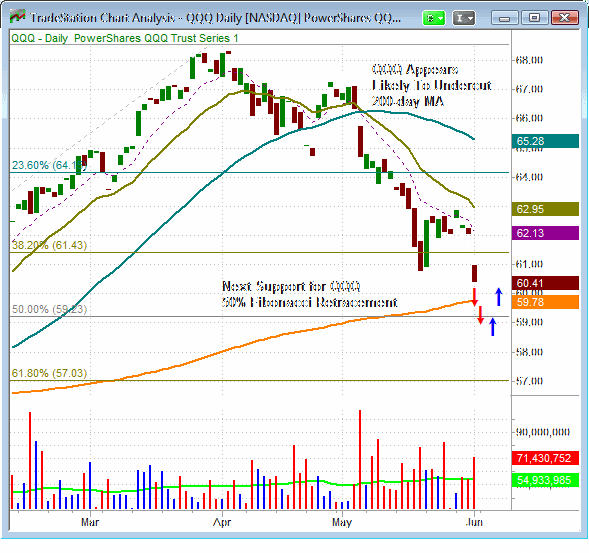5 Reasons Stocks May Soon Move Lower ($SPY $DIA $QQQ $MDY $IWM)
Post on: 28 Сентябрь, 2015 No Comment

Oct 08, 2012
7 Flares LinkedIn 3 Twitter 4 Facebook 0 Google+ 0 7 Flares
After several months of being in confirmed buy mode, our market timing model just shifted to neutral at the close of trading on October 5 (last Friday). Along with several proprietary signals that comprise our reliable market timing system. there are 5 objective, technical situations occurring right now that indicate the overall stock market may soon be headed for a substantial move lower. As a reader of our trading blog, we wanted to promptly alert you to these key developments that could impact your investing and trading accounts if you are complacent. Below is a summary of the 5 reasons we believe stocks will soon be headed lower, followed by more detailed analysis on each of the five points:
- Four distribution days on the Nasdaq
- Lack of increasing volume as the market has been rising
- Key short-term resistance levels being tested on the S&P and Dow ($SPY and $DIA)
- Head and Shoulders pattern on the Nasdaq 100 ($QQQ)
- Relative weakness in the small and mid-cap indexes ($IWM and $MDY)
Volume is one of the most reliable technical indicators at our disposal, and it is a leading (not lagging) indicator as well. Thats why we discuss the stock markets price to volume ratio in our daily ETF market analysis. Last Friday (October 5), total volume in the Nasdaq ticked 3% higher than the previous days level, while the Nasdaq registered a 0.4% loss. The higher volume decline in the Nasdaq caused the index to register another bearish distribution day, indicative of selling amongst banks, mutual funds, hedge funds, and other institutions. This means the Nasdaq has now suffered four distribution days in recent weeks. As we mentioned last week, the presence of four or more days of higher volume selling (distribution days) in an index is frequently an early warning signal that the near to intermediate-term uptrend in a market is in danger of ending. Furthermore, its concerning that the broad markets recovery off the September 26 swing lows has generally lacked increasing volume on the way up. Given recent volume patterns, there are now much greater odds of at least substantial price correction in the broad market on the horizon, particularly in the Nasdaq.
The first two of the five reasons we feel stocks are soon headed lower are discussed in the paragraph above. Next, lets look at charts of the major indices that illustrate and explain the remaining three reasons. Specifically, we will briefly analyze chart patterns of the following ETFs that are popular ETF proxies for their respective underlying broad-based indexes: S&P 500 Index ($SPY), Dow Jones Industrial Average ($DIA), Nasdaq 100 Index ($QQQ), small-cap Russell 2000 Index ($IWM), and S&P Midcap 400 Index ($MDY).
Because it is a narrow index comprised of only 30 stocks, the direction of the Dow Jones Industrial Average is not really a good indicator of overall stock market health. Nevertheless, because the popular financial news media outlets always seem to focus on how many points the Dow is up or down each day, the technical importance of the index becomes self-fulfilling, due primarily to retail investors basing their market decisions largely on the performance of the Dow. That being said, lets look at the daily chart of $DIA, the most well-known ETF that tracks the index:
The benchmark, broad-based S&P 500 Index has a similar chart pattern to the Dow, in that it is also testing resistance of its prior swing highs, although it has been showing slightly less relative strength during the most recent climb off the September lows. Below is the daily chart of the S&P 500 SPDR ($SPY), the main ETF proxy for the performance of the S&P 500 Index:

Although both DIA and SPY are testing resistance of their prior swing highs from September, such action alone would not be concerning because the indexes could simply form a multi-week base of consolidation near current price levels, then eventually continue to new highs again. However, of legitimate concern is the relative weakness in QQQ, IWM, and MDY. For example, QQQ is presently forming the right shoulder of a bearish head and shoulders pattern , which is most easily annotated with an intraday chart interval of 120 minutes (each bar is two hours of price action):
A head and shoulders pattern that forms after an extended rally follows through to the downside a relatively high percentage of the time. However, with this pattern, we typically would not initiate a short position or use it exclusively as a signal to exit a position until it follows through to break the neckline after forming the right shoulder. This is because failed head and shoulders that rally above the head after forming the right shoulder often lead to explosive upside moves. Therefore, although QQQ is looking pretty bad in the near-term, due to the formation of the right shoulder, we would need to see a breakdown below the neckline before selling short QQQ or buying the corresponding inversely correlated ETFs ($PSQ or $QID).
Although our system for trading ETFs affords more flexibility than our stock trading strategy in flat to downtrending markets (with typically lower gains as well), our strategy for swing trading individual stocks is focused primarily on profiting from momentum in leading small and mid-cap stocks. As such, what may be even more concerning than the head and shoulders pattern on QQQ is the relative weakness both the small and mid-cap indexes have been exhibiting since rallying off their late September lows. Using the Fibonacci indicator on the daily chart patterns, notice that both IWM and MDY have only recovered about 50% of their respective declines from the mid-September highs to late September lows:
Unlike DIA and SPY, both of which have already rallied back to test resistance of their mid-September highs, notice that IWM and MDY have only managed to recover about 50% of their respective price retracements off their prior highs. Further, the two charts below show that the Relative Strength line (RS line) in both IWM and MDY is breaking down ahead of the price. This is another indication of relative weakness in small and mid-caps:
%img src=http://www.morpheustrading.com/
rick//charts/2012/121008IWMRS.png /%
%img src=http://www.morpheustrading.com/
rick//charts/2012/121008MDYRS.png /%
The four charts of IWM and MDY above indicate that institutions have been avoiding rotation into more volatile and aggressive small and mid-cap stocks in recent weeks, thereby pointing to a decreased appetite for risk . This recent decline of bullish momentum in small and mid-cap stocks is why we said in our October 3 newsletter were shifting to a more proactive stance with regard to tight stops on existing stock positions, as well as reducing share size on new trade entries.
The increasing occurrence of distribution days on the Nasdaq, the lack of increasing volume on the way up (accumulation days), resistance in the S&P and Dow, the head and shoulders pattern on QQQ, and relative weakness in small and mid-caps are 5 good reasons why the overall stock market may soon be setting up for a substantial downward price correction. Nevertheless, long-time subscribers of The Wagner Daily know we are not in the business of predicting what the market will do; rather, we continually remain prepared for the most likely scenarios to occur, and then make the necessary reactions to what the market gives us. Put quite simply, its imperative to remember that our successful trading system relies on trading what we see, NOT what we think . We already have tightened our protective stops in the event of an anticipated correction, and are even prepared with a possible short position (or inverse ETF position) in QQQ should it break down below support of its neckline on the chart above.
The commentary above is an excerpt from the October 8 issue of The Wagner Daily. our end-of-day stock and ETF trading newsletter for short-term traders, published since 2002. Subscribers to this top-ranked ETF and stock picking service version receive our best ETF and stock swing trade setups with preset entry and exit prices, access to our proven trading strategy with market timing system, and access to our turn key technical stock screener software. Start your 30-day risk-free subscription for less than $2 per day (based on annual rate) by clicking here .














